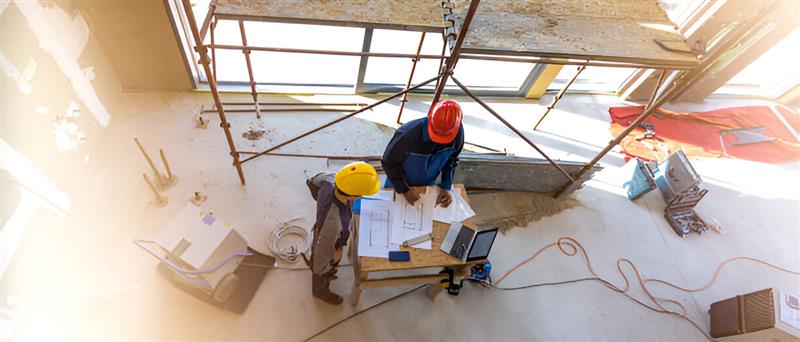What Does a Settling Foundation Look Like?
Common Signs of Foundation Settling
Foundation settling often starts subtly but can lead to serious structural issues if left unaddressed. Wisconsin homeowners should watch for common indicators such as:
- Cracks in walls and floors: Hairline cracks in drywall, ceilings, or basement floors may indicate foundation movement.
- Uneven floors and doors that stick: Floors may slope, and doors or windows might become difficult to open or close.
- Basement floor sinking: Noticeable depressions in the basement floor could signal foundation instability.
Why Homeowners in Wisconsin Should Act Quickly
Ignoring signs of a settling foundation can lead to costly repairs, diminished home value, and safety risks. Prompt action helps mitigate damage and prevents further complications.
How Wisconsin’s Unique Soil Types Contribute to Foundation Settling
Wisconsin’s diverse soil compositions and geological characteristics significantly impact foundation stability.
- Overview of Milwaukee and Regional Soil Types: Many areas in Wisconsin feature clay-rich soils, sandy soils, and glacial till, each affecting foundations differently.
- Clay-Rich Soils and Their Behavior: Expansive clay can swell when wet and shrink during droughts, leading to foundation shifts.
- Soil Erosion Effects on Foundation Stability: Heavy rains can erode loose soils, destabilizing foundations over time.
- Seasonal Swelling and Shrinking of Soil: Frequent freeze-thaw cycles exacerbate soil movement, straining foundations.
The Role of Wisconsin Weather in Foundation Problems
Wisconsin’s weather patterns are another major factor contributing to foundation issues.
- Freeze-Thaw Cycles and Soil Expansion: Frost heave during winter can lift foundations, creating uneven settling when the ground thaws.
- Heavy Rainfall and Its Impact on Soil Erosion: Saturated soils lose their strength, leading to foundation settling.
- Drought Conditions Causing Soil Shrinkage: Extended dry spells can cause clay soils to contract, resulting in foundation gaps.
Local Environmental Factors That Impact Foundations
In addition to soil and weather, local environmental conditions play a role in foundation stability.
- Proximity to Lakes and Water Table Fluctuations: Homes near lakes or rivers face risks from fluctuating water tables and potential flooding.
- Urban Development and Its Effects on Drainage: Construction and paved surfaces alter natural water drainage, increasing foundation stress.
- Tree Roots and Nearby Vegetation Affecting Soil Stability: Large trees near homes can absorb moisture unevenly, destabilizing surrounding soil.
The Impact of Construction Practices on Foundation Stability
How a home was built significantly affects its susceptibility to settling.
- Improper Site Preparation: Inadequate grading and soil compaction during construction can lead to premature settling.
- Age of Homes and Historical Construction Trends: Older homes often lack modern foundation reinforcement techniques.
- How Foundation Design Adapts to Wisconsin Conditions: Properly designed foundations incorporate drainage systems and materials suited to local soil and weather conditions.
Preventing Foundation Settling in Wisconsin Homes
While foundation settling is common, preventive measures can reduce the risk.
- Importance of Proper Drainage Systems: Directing water away from the foundation helps minimize soil erosion and water damage.
- Managing Landscaping to Minimize Soil Movement: Strategic planting and grading prevent moisture imbalances around the home.
- Regular Inspections and Maintenance: Routine checks by professionals can catch early signs of settling, avoiding costly repairs.
How to Address a Settling Foundation: Stabilization Methods
If foundation settling has already occurred, several effective repair methods can restore stability:
- Common Foundation Repair Techniques: Tailored solutions depend on the type and severity of the issue.
- Piering and Underpinning: Steel piers are driven deep into stable soil to support the foundation.
- Mudjacking for Sinking Concrete: This process lifts sunken slabs by injecting a concrete mixture underneath.
- Foundation Sealing and Waterproofing: Protects against further water damage and soil erosion.
- Costs and Considerations for Homeowners: While repair costs vary, addressing the issue promptly often saves money in the long run.
When to Call a Professional for Foundation Issues
Knowing when to seek expert help can save homeowners from escalating problems.
- Recognizing When DIY Fixes Aren’t Enough: While minor cracks might be manageable, significant settling requires professional attention.
- Choosing a Local Wisconsin Foundation Expert: Look for experienced, licensed contractors familiar with regional conditions.
- Questions to Ask Before Hiring a Contractor: Inquire about warranties, repair methods, and customer reviews.
Success Stories: Repairing Foundation Issues in Wisconsin Homes
Real-life examples illustrate the benefits of addressing foundation settling:
- Real-Life Examples of Foundation Stabilization: Wisconsin homeowners have successfully resolved issues using advanced techniques like piering.
- Testimonials from Homeowners: Satisfied customers report restored home stability and peace of mind.
- Long-Term Benefits of Addressing Settling Issues: Proper repairs enhance safety, property value, and structural longevity.
Future-Proofing Your Wisconsin Home’s Foundation
To protect your investment, consider these proactive strategies:
- Tips for New Home Buyers: Evaluate soil conditions and foundation quality before purchasing.
- Ongoing Care to Prevent Settling: Regular maintenance and landscaping adjustments minimize risks.
- Adapting to Climate and Soil Changes Over Time: Stay informed about local environmental shifts to safeguard your foundation.
By understanding the unique challenges posed by Wisconsin’s soil, weather, and environmental factors, homeowners can better protect their homes against foundation settling. Addressing issues early and taking preventive measures ensures long-lasting stability and peace of mind.


Recent Comments